The New Soul and Structure of the Post-Management Corporation
Will managers become superfluous to the 21st-century corporation? And if so, what does this portend for individual workers and their leaders, and for the company itself and its potential for success? The authors argue that we are headed for "managing without management" because a powerful service culture will predominate and become the overwhelming force driving a corporation and its growth. In the process, a hard-nosed and simplified approach to corporate strategy will become the name of the game.
Influenced by the power of the customer, a post-management corporation will confine itself to a single business because it will need an unwavering focus to live up to its customers' expectations and be competitive in a worldwide market. To make this business work effectively, a strong and simple corporate culture will be built around a leadership team that utilizes information technology to connect with a well-paid work force operating in relatively small, decentralized business units.
Outward-looking, nimble and innovative, the new corporation will preclude the kind of protective, empire-building behavior that today's multilayered giants exhibit. Yet while the post-management corporation will be different, it will not be Utopian. Employees will need to do more, do it better and be more collaborative. Job security, not exactly a sure thing today, will most definitely be a thing of the past. On the plus side, however, the organizational alienation that goes with the large, bureaucratic corporation will be minimized. The leadership, meanwhile, will devote the majority of its time to customers and suppliers, rather than the internal activities of administration, supervision and control.
Since the beginning of the post-World War II period, society has been relying on big business to employ large numbers of people after they have left or completed school. Society also has expected that time and seniority will bring more responsibility and higher pay, that there will be a large pension at the end and that, even if an individual loses a job, there will be many organizations ready to supply another. Those who attained certain levels of qualification or experience could feel secure and confident that the corporation would provide.
Those days are going fast and it is easy to see negative trends. It is becoming increasingly difficult, for example, for young people to get started in proper jobs. It is now easier at any stage to lose a job. The secular trend of unemployment is rising everywhere while people are remaining jobless for longer. Companies are focusing on the core workers they need, and large parts of the earlier work force, often a majority of it, become redefined as contract workers or hired hands, working on short-term contracts, part time or only when needed.(1) A new and ever-swelling pool of less-skilled workers is being created. Economic inequality is rising.
But even the core workers are often threatened and unhappy. Many of them are working more hours and surrendering large tracts of their private lives, partly because they feel insecure about the future and partly because their companies demand it.
It is not just particular jobs and careers that are disappearing. The concepts themselves are under attack. William Bridges argues that the whole idea of having a job will disappear.(2) The contention is provocative and highlights a real trend.
We believe, however, that jobs will still exist long after managers and management have gone. Rather, the rules of how to get on in life are being subverted. Even when people are better off, they feel worse. The rise of what we call "managing without management" -- whereby entire categories of specialized managers will be dispensed with as new forms of less-bureaucratic leadership and entrepreneurial organizations emerge -- will increase insecurity and unemployment even further. This is certain to happen since one of the largest categories of employment everywhere in the industrialized world is currently that of "manager." Technology, automated financial-control mechanisms and new forms of customer-oriented organizations render that category increasingly obsolete.
We have seen a similar shift, and a similar negative reaction, before. The Agricultural and Industrial Revolutions destroyed the village community and the prevalence of rural employment and values. They gave us large cities, and large numbers of jobs in large organizations. They supplied what is only now being destroyed.
Most sensitive and intelligent observers of the Agricultural and Industrial Revolutions deplored their effects. Blake, Shelley, Wordsworth, Carlyle, Disraeli, Dickens and a host of other commentators hated the new world and wanted to put the clock back. It was not to be.
Today also, there is no going back. The forces at work are too powerful. Even countries or regions cannot stand against the trend, whatever national political party or leader is elected. The obsession for better corporations and societies will inevitably lead to the spotlight being put on one of the remaining vested interests not yet challenged, that of the management class.
The Power of Service: An Engine for Growth
Being better is not, however, just a matter of being more productive. Being better means being different in heart and soul. Being better means that the purposes, driving forces, culture, behavior standards and results of today's corporation -- where, typically, 20 percent of a company's business provides it with 80 percent of its profits -- are more closely aligned to human needs, aspirations and potential.
For a start, the corporation of the future will have a noble external purpose. It will exist to serve people and causes outside itself. Many corporations are already trying to articulate this, through statements of mission or vision or cause. It is easy to be cynical about such exercises, but real progress is being made. Today, many corporations do try to serve their customers wholeheartedly, in a way quite different from the standard prevailing a generation ago. Some companies have gone beyond serving customers to defining their purpose as more far-reaching, such as Body Shop's efforts to change standards in the cosmetics industry to reduce harm to animals and the environment.
Service to others is not just a noble ideal. It is also a satisfying and absorbing process for those doing the serving. A culture that knows it is enriching the world and raising standards can become a unifying force. It is much more fun to work in an organization that has a purpose than in an equivalent one that does not.
This power of service will deliver what most corporate leaders are now seeking -- a means of fueling growth. There is an increasing desire for growth and momentum in the corridors of most large corporations. And there is an emerging body of academic opinion suggesting that this momentum will be the key differentiator of successful companies in the next few decades.
No Utopia
While the post-management corporation will be different from the corporation of today, it will not be Utopian. The challenges employees face will be greater. They will need to do more than they do now, and do it better. They will have to be more flexible and develop new skills. They will also have to serve the corporation's purpose, and either conduct business in the way the leader wants or leave. Job security will be a thing of the past. Employees will be forced to be collaborative. But they will also have to be more independent, self-reliant and self-starting.
Employees will have to cope with a succession of projects and with ambiguity at most turns. They will have to stretch themselves, and have less security, both material and psychological. They will have to plan their own careers, continuously enhancing and updating their skills. They will have to work harder, and probably more hours, too. They will go home tired. But it will be different. The work will be an extension of themselves. The organizational alienation that goes with the large, bureaucratic corporation will be minimized. The employed will not be alienated, just as the alienated will not be employed.
The post-management corporation will be more creative. It used to be assumed that creative individuals should go into the arts, the media, academia or, if forced into something commercial, then into public relations, advertising, merchant banking, consulting or small business rather than into mainstream companies. This assumption, correct even today, will become outdated. Creative individuals will find they are needed in the new corporation.
Commitment, Cynicism, Self and the Customer
It has become a weary cliché that commitment is demanded by ambitious companies. The archetype is the large American investment bank where they say, "Commitment is very important to us." Commitment is a form of thought-control, used to make naturally individualistic and selfish people act in a quasi-collaborative way for the good of the company. While the ideology works, and everyone subscribes to it, everyone is also basically cynical about it. Privately, those running the banks acknowledge that all loyalties are ultimately personal loyalties, ties from one person to another.
The post-management corporation will not be like that. Not because human nature is going to change, but because the corporation will be externally focused; and the degree of external success will be visible to all. Internal processes will be much less important. These internal processes will also be very simple, with a homogeneous culture and people suited to it. Work will take place in relatively small, decentralized units where everyone can know each other and the value of the "doer" is better recognized. Politics will still exist, within and between units, but since the focus of the corporation will be external, especially directed toward customers, the extent and importance of politics will be greatly diminished. The customers will have a strong influence on who is to be promoted and who has to leave.
Within the post-management corporation, honesty about performance will be the best policy, and usually the only feasible one. No hiding behind confusion and no cover-ups of weaknesses. Those who are fortunate will think of work as an extension of themselves. Regrettably, those who are not will be unemployed. It is relatively easy to dissimulate with colleagues. It is much more difficult to do so with customers. Automated performance measures -- which utilize information technology to let leaders and doers know the immediate financial and operational effects of their actions -- will tell all. Greater personality and collective fun will become compulsory, because only those who enjoy serving customers will be around to do so.
In Search of Global Simplicity
The soul of the organizatioj will include the sentiment of the global pioneer. The new leaders will be obsessed with covering every corner of the globe with their presence. They will be glad to go on vacation to remote parts and see their services and products wherever they go. They will be delighted with the simplicity of their business and will always be seeking ways to make their product range simpler to develop and manufacture. They will want to be able to plug into their worldwide information technology network from anywhere and know the truth about their business.
Prerequisites for Success: A Restructuring of Larger Corporations
The achievement of a post-management corporation cannot take place, however, without a change of structure as well as a change of heart.(3) To change that structure requires the following:
- Leaders who live and breathe like shareholders.
- A customer-dedicated leadership team.
- A strong and simple corporate culture built around the "leadership team."
- Investments and acquisitions that rapidly accelerate global corporations.
- An information technology system that reports operating and financial performance visibly throughout the organization.
- Simplicity -- ideally single-business corporations.
- A compensation structure that will reward the "doer" more highly (more pay for the workers).
Perhaps the three most difficult conditions for management are the last three. Managers have a natural desire to hedge bets, hide problems and create empires through the propagation of multibusiness corporations and the lack of clear reporting about performance. They are also unlikely to give up their pay differentials to restore greater equality with the "doers." These are the subconscious props that managers cling to and that could prevent the early implementation of the post-management corporation.
Removal of the props should be encouraged: oil companies should not only stick to oil, but they should create simple, standardized business units throughout the world and operate with a structure more like that of the Roman Catholic church: four layers, a few principles and a universal manual. Engineering companies could usefully stay out of entertainment and focus on the massive task of globalization of products. Telephone companies may be better off focusing on phones and information transmission than being trapped by exciting new information-based businesses.
A milestone in the creation of the post-management corporation will therefore be the splitting up of complex conglomerates. General Electric and Daimler-Benz, United Technologies and Allied Signal, Granada and Grand Metropolitan would focus on strategic innovation at the business unit level rather than on corporate cleverness. In fact, they would not exist in their current forms.
The Economics Driving the Post-Management Corporation
The restructuring of large corporations and the discovery of a new soul, however, are still not quite enough. The proof will be in the ability of the new organization to generate revenue growth and take further costs out of the system at the business unit level.
Arithmetically, we mean that within a 10-year period, by the year 2006, a company's total unit overhead costs (that is, all value-added costs excluding direct labor, and excluding also bought-in raw materials, components, goods and services) should be no more than 20 percent of today's level. Note that we say total unit overhead costs. We expect that more than half the improvement will come from a halving of overhead costs and the rest from a doubling of profitable revenues.
The costs we are targeting include all indirect and overhead costs of whatever description. All costs of running offices, distribution centers and sales forces. All costs of functional departments, such as production overhead, research and development, computing, systems design and marketing. And all costs of administration and anything related to management, including those at the head office, in individual countries and at divisional levels. To repeat, all costs except direct factory labor and bought-in supplies.
The relevant costs typically represent at least 40 percent of a company's total costs, or 80 percent of its value-added costs, as shown in Exhibit I.
Exhibit I
Typical Cost Structures Today and in The Post-Mangement World
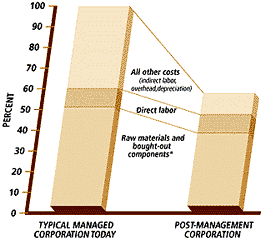
*These also come down, because suppliers also cut out their surplus overheads
Source: Koch and Godden, "Managing Without Management"
We exclude factory direct costs in this estimate for two reasons. One is that the competitive battle from roughly 1960 to 1990 was fought in the factory. In the 1960's and 70's, Japanese companies in particular established competitive advantage in many targeted industries, notably consumer electronics, office electronics and automobiles, by having better factories that produced lower-cost and higher-quality goods. In the 80's, the Western companies woke up to the challenge. The copycat fight against Japanese global market leadership in certain products required American and European companies to establish factories that were equally efficient, low cost and high quality.
This war has, in general, now been resolved: either by some Western companies giving up (as in motorcycles) or by their attaining comparable factory standards (in automobiles, Ford is now reckoned to be similar in efficiency to the Japanese). With the factory wars over, it is time for the office wars. (By office, we mean everything that happens outside the factory.) The efficiency of the office is at least as important as that of the factory in delighting, or failing to delight, customers. The post-management corporation will, naturally, have lean production facilities, and will strive for continuous improvement there. But its success will derive mainly from competitive advantage outside the factory.
The second reason for excluding factory direct costs is that, because of the very success of the factory wars in improving shop floor efficiency, they now constitute a small minority of companies' total costs. The effects of better factory management on cost structures are shown in Exhibit II.
Exhibit II
A Typical Corporation's Cost Structure In 1960 and 1995
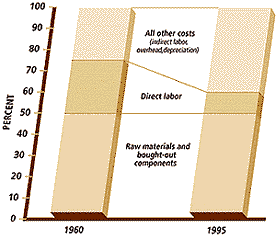
Source: Koch and Godden, "Managing Without Management"
Whereas direct labor accounted for around 25 percent of total costs in 1960, the figure today is likely to be 10 percent at most. In 1960, direct labor was more important than all other value-added costs. Today, those other costs are at least four times more important than direct labor. Clearly, cost structures have become unreasonably tilted toward overhead, as management and other office expenses have claimed more and more of the corporate cost pie.
The office wars and the quest for the post-management corporation will carry the struggle for productivity and customer delight into the heartland: that of management itself.
For a few companies, while factories have been streamlined and many direct labor jobs eliminated, the management heartland has been exempted and this is virgin territory. For most companies, the outskirts of management have recently been subject to scrutiny.
How Is It Possible to at Least Quadruple Productivity?
How can it be possible to at least quadruple productivity within 10 years? That might be feasible within factories, but surely not throughout the company. Yet the concept of the post-management corporation requires that productivity outside the factory be at least quadrupled.
If sales did not increase in real terms over and above inflation, our goal would require all overhead costs to be cut by 80 percent. This would apply both to people and to non-people costs. In rough terms, the number of managers and other white-collar staff would be cut to a fifth of today's level. To do the same work with a fifth of the people may well seem preposterous.
But it will not have to work like this. There may be a few isolated instances in which the cuts in the non-factory work force will be this extreme. In general, however, the post-management corporation will experience a halving of the relevant work force between 1996 and 2005. This will cause a doubling of productivity. The other part will come from a more than doubling of real sales in profitable products and services. The doubling in sales will arise from increases in customer loyalty and market share, with only minor help from market growth.
The typical post-management corporation, therefore, will have doubled profitable sales and halved costs, including a halving of employees. As we are saying that this must happen over a 10-year period, by 2005 this implies an average annual growth in profitable sales of 7 percent, and a reduction in relevant personnel also by 7 percent a year.
How Can Costs Be Halved?
How are each of these changes possible? Let us start with the cost side, and, within that, the deployment of management time.
Senior executives of large corporations tend to spend about 80 percent of their time on internal matters. That would not necessarily be a bad thing, if the time were being used to exert leadership and create excitement about serving customers, to create new products and services, or to make strategic decisions and solve major operational problems that could not be resolved further down the organization.
We have examined the daily lives of several senior executives to understand how they spend their time. Most of it is spent in reactive problem-solving and in what are best described as meetings of discovery. The executives spend at least 30 percent of their time in these meetings discovering what has happened, almost always when something has gone wrong, trying to identify why, apportioning blame and determining who should do what.
They spend another 15 to 20 percent of their time on the politics associated with these meetings: who was really to blame, who knows and needs to know, how to prevent certain people from knowing, how the disaster and the associated meetings will affect an individual's career, and whom to speak to in order to modify or reverse decisions previously taken.
A further 30 percent of the executives' time is spent on what can only be described as administration or, being generous, administrative leadership: memos informing people about events and procedures to be adopted, about changing organizations and new appointments, about decisions on such matters as corporate car leasing, personal documentation of country club memberships, expense justifications, share option details and a myriad of other internal matters.
This leaves between 20 and 25 percent of the time for high-value-added tasks, such as:
- meeting customers (typically about 5 percent)
- meeting suppliers (also typically about 5 percent)
- visiting operations (typically less than 5 percent)
- coaching and team building (also typically less than 5 percent)
- strategic decision-making, including writing and reviewing plans and budgets (typically about 5 percent).
Exhibit III summarizes our analysis of management time.
Exhibit III
A Breakdown Of Mangement Time
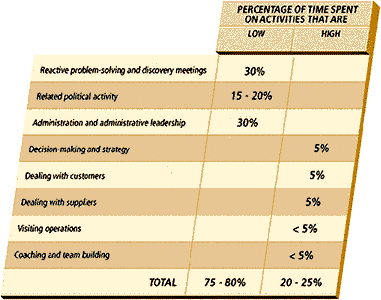
Source: Authors' survey of C.E.O./C.F.O. and senior divisional directors' time
Clearly, if more than 75 percent of the time is not adding value for customers, either directly or indirectly, there is the potential to double the productivity of management time. This requires major and discontinuous change -- in attitudes, behavior, organization and culture -- but it can be done.
In the new world, senior executive time would be refocused on genuine leadership functions, not administration. These qualities of leadership usually imply:
1) Openness and ruthless decisiveness, resulting in a massive reduction of paperwork, memos, political maneuvering, self-justification and administrative padding.
2) Self-confidence, eliminating the need for empires, safety nets and such back-covering devices as large planning groups.
3) Speed of decision-making, preventing prevarication and political alliances.
4) Simple measures of success, allowing concise reporting and documentation.
5) An air of excitement and the pioneering spirit, requiring a focus on external matters.
Not all the costs we are targeting, however, are management ones. The rest are clerical and technical. Here the nature of the change is different. Part of it derives from streamlining, using the same techniques to automate the office that have been used for 40 years in improving factory efficiency and quality. Partial results from the application of re-engineering have typically raised productivity by between 30 and 40 percent (they are partial because they are applied to only part of an organization or a limited number of operations). The change we are talking about affects the whole corporation and is not just efficiency related.
Clerical and technical costs can be reduced well beyond the 30 to 40 percent range yielded by re-engineering. Part of the further improvement comes from cutting out supervision time: the mirror image of the change in the manager's time utilization. Another part comes from cutting out other superfluous activities that are undertaken, nonetheless, for human reasons, because people are not totally engaged by what they are doing. Another tranche of cost is cut because the company focuses on those products and services that require relatively little overhead per dollar of sales. Yet more time is eliminated because the corporation is simpler and does fewer things, requiring less coordination.
Provided the willpower is there, a 50 percent improvement in office and related productivity, within five years, is attainable.
How Can Sales Be Doubled?
The post-management corporation aims for a doubling of profitable sales over 10 years. There are four reasons, which we will review shortly, for thinking this is attainable. Before that, let us explain why we use the term "profitable sales."
We have found that when a corporation's sales are properly segmented into groups of products and customers that face different competitive conditions, there are nearly always three broad bands of business.
At the top end, about 25 percent of the number of business segments contribute about 50 percent of sales and 75 percent of fully costed profits.
At the bottom end, some 50 percent of the segments account for about 25 percent of revenues but, in the aggregate, make no profit. (The worst of these segments actually make quite large fully costed losses; the best of the bottom 50 percent of the segments make a small fully costed profit but not enough to cover the cost of capital. In the aggregate, then, these segments make zero percent return.)
In between are 25 percent of the segments, which produce about 25 percent of the revenues and 25 percent of the profits.
From these observations, we have distilled two rules.
One is the 25/50/75 focus rule. This says that you should focus on expanding the 25 percent of the segments that produce the 50 percent of the revenues that contribute 75 percent of the profits. These segments are also likely to be the areas in which customer satisfaction and repeat purchases are highest, so that it is relatively easy and rewarding to expand market share there.
There is also the 50/25/0 rule, which states that you should exit the 50 percent of the segments that produce just 25 percent of the turnover and no profit.
The profitable sales that you should seek to double are therefore generally only 75 percent of your existing sales. This means that the total level of sales need only go up from today's 100 percent to a target of 150 percent, provided you first cut out all unprofitable sales. The effect will still be to double profits even without any cost reductions. You should, of course, try hardest to expand the sales of your most profitable segments, which can clearly have a more than proportionate effect on profits.
The task of doubling profitable sales is less daunting than that of doubling total sales. But it is a doubling, nonetheless, of those products and services representing 75 percent of sales. There are three reasons we think this is possible.
The first is that the efforts of the most senior people in a post-management corporation will be directed toward things of direct value to customers, rather than, as at present, principally toward the internal activities of administration, supervision and control. The profile of top executives' time, today and in the post-management corporation, is shown in Exhibit IV.
Exhibit IV
How Top Executives Spend Their Time: Switching Priorities
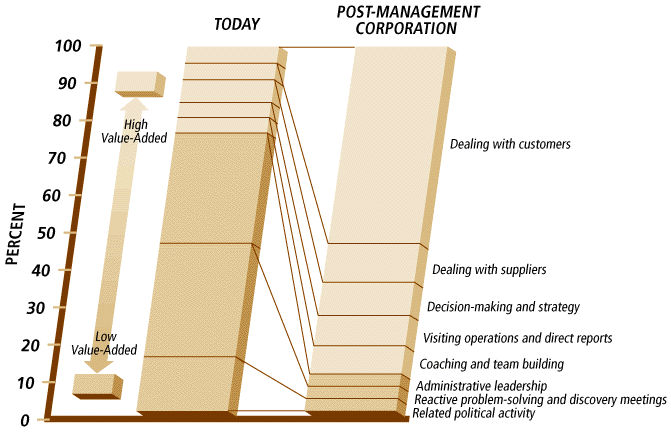
Source: Koch and Godden, "Managing Without Management"
Note that the amount of time devoted to customers and suppliers increases from an average of about 10 percent today to a typical 65 percent: more than six times today's level. Is it unreasonable to expect a doubling of sales to result from a sixfold increase in the most valuable executive activities?
The second reason a doubling of profitable sales is possible is because of the dynamics of customer loyalty and retention. These are absolutely critical in the fight for market share, yet few executives really understand and exploit the dynamics.
To appreciate this, calculate what your customer retention ratio is. Of the customers you have this year, how many will be customers (of roughly equivalent value) next year?
Customer retention ratios vary enormously, not just between different industries, but also between different companies in the same industry. These differences in retention frequently explain all of the difference in profitability between competitors.
Assume that your company's customer retention is 20 percent, meaning that only 20 percent of the value of purchases made in 1997 comes from customers you had in 1996. Now assume that you raise the customer retention ratio by 5 points, to 25 percent. Your 1997 sales will be 25 units (from 1996 customers) plus the 80 units sold to new customers, or a total of 105 compared with one year earlier.
A 5-point increase doesn't sound like very much. But continue to add that amount to your customer retention ratio each year, and the effect becomes very much more marked, because you will be retaining a greater proportion of a larger number, thus compounding the difference over time. As Exhibit V shows, by the fifth year your sales will have increased by more than 37 percent.
Exhibit V
The Big Bounce: How a Small Increase In Customer Retention Adds Up
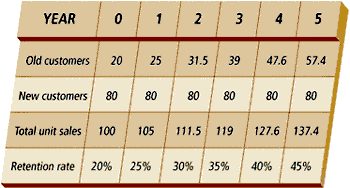
Source: Koch and Godden, "Managing Without Management"
In practice, the effect of increasing customer loyalty is greater than this. From our observations, the only way to increase loyalty is to deliver superior customer value. Many customers buy the same product from more than one supplier. Increasing your share of the customer's business is a very practical way to raise sales and market share steadily. You may also be able to deliver extra value to customers and raise the prices you realize from existing products. Or you may be able to encourage the customers to trade up to more expensive products. Further, customers may be persuaded to buy some different goods from you, particularly if made more fully aware of your product or service range. This is relatively easy if you start with a delighted customer. One useful tactic is for product suppliers to provide an expanding range of services, too -- everything from credit supply to after-sales maintenance and enhancement. A happy customer can be converted into a bigger customer.
Incidentally, creating and retaining loyal customers, and selling more to them, has a beneficial effect on the cost side of the equation. As a result, loyal customers are much more profitable than other customers.
For a start, loyal customers do not involve the company in many of the costly overhead activities, such as new sales and marketing efforts, that are necessary to attract new buyers. Loyal customers generally buy in greater quantities. They also have lower order fulfillment costs.
But loyal customers are not just more profitable because they are less costly to serve. They are also generally much less price sensitive than new customers, especially in service industries. It has been calculated that raising the percentage of customers retained annually by just 5 points can raise profits by between 25 and 50 percent. Customer loyalty alone, therefore, can often supply the doubling of profitable sales that we are looking for.
The third way of looking at the required increase in profitable sales of 100 percent over five years is to realize that this translates to an increase of 15 percent per year. Many companies have consistently beaten this target, year after year, for quite long periods: the AES Corporation, Astra, CNN, EDS, Federal Express, Filofax and Ikea, to name just a few from the first half of the alphabet that spring readily to mind. In general, they have done so by taking market share away from competitors and by inventing new products and services to sell to existing customers. We believe that the growth rate of a corporation is related much more closely to its culture and expectation of what acceptable growth is, than it is to external market conditions. If people are required, expected and supported to produce sales growth of 20 percent per year, they can usually find a way to do it.
Is It Really Practical to Create a Post-Management Corporation?
Our client work in North America and Europe has revealed many practical examples of the potential for the post-management corporation. In this section we show one prospect from a multibillion-dollar company that is admired from the outside, on both sides of the Atlantic, as being well managed and successful.
The company has four similar but essentially unrelated divisions. It has "delayered" and removed a level of regional management, which previously created a cumbersome matrix. It has gone through transformation programs on product develop- ment and operations that are typical of the 1990's. It is applying best practices across its organization. It is extracting extra corporate value from coordination of purchasing and strong financial control. The only area where it may be behind the latest techniques is in strategic sourcing. It does not have a particularly good system of delivering value through working with its suppliers.
Despite these initiatives, it has a classical management hierarchy and the costs that go with it: a pyramid structure with six or seven layers of management and similar levels of authority and numerous functional or "process" managers (many organizations have simply re-labeled!). The group C.E.O. and the divisional C.E.O. receive standard financial reports on business unit performance every month and summarized reports on overall trends in sales, order intakes, cash flow, profitability, working capital and head count. They hold regular meetings to discuss performance, mainly by exceptions. Special task forces are created when something goes wrong or to change the practices within certain parts of the organization.
The resulting slimmed-down structure (see Exhibit VI) is fairly typical of many decentralized organizations in the 1990's. So, where is the opportunity?
Exhibit VI
Delayering The Corporation, But Not Going Far Enough
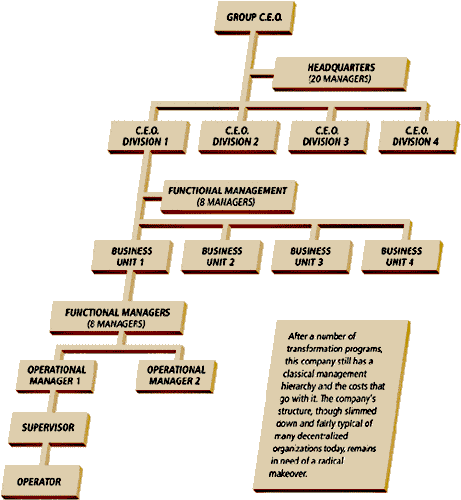
Source: Koch and Godden, "Managing Without Management"
In theory at least, the four divisions could operate independently as separate corporations, eliminating a certain amount of internal politics but more importantly creating a greater drive for international expansion, rather than horizontal expansion through adding new divisions. In practice, however, the company is short of personality leaders at divisional level. The culture of strong financial control and corporate decision-making has prevented the divisional teams from developing their own values and cultures.
In theory at least, the divisional C.E.O. could cope with direct weekly reports showing the performance of his 40 main factory floor machine cells and 20 other significant operations/programs, and would therefore be able to see how the total operation is doing on-line. In practice, he cannot do it because the systems are not in place and there is no commonly agreed set of operating measures to go alongside the good, standard financial parameters.
In theory, two more layers of management could go. In practice, the layers of management are required for two reasons: because the 10 middle managers in business unit 1 do not have direct relationships with the 14 middle managers in business unit 3 and perceive them as competitors for capital and favors; and because the operations managers are not of great enough stature to lead their units, nor are the business unit managers close enough to operations to be able to deal with them directly.
In theory, four or five experienced people could be responsible for the senior customer relationships. In practice, 10 to 15 managers feel at least partly responsible for delivering customer value, all from different functional perspectives.
Our vision, although still seen through a glass darkly, would be for a radical restructure. Perhaps it would be along the following lines. First, a small divisional leadership team of three or four people would be created, built around a strong, ambitious personality. This team would be responsible for all customer programs and for performance of business operations worldwide. It would be supported by an information system that allowed all members on-line access to the 40 machine cells and 20 other operating units. The operations would report into this team directly, with the operations managers being responsible for profits and losses -- a radical shift downward in P.&L. responsibility. Each of these leaders would have access to the performance not only of their own operations but of their equivalents throughout the world. These people would meet customers and each other regularly.
Our suspicion is that at least 60 percent of the current management activity would actually disappear and around 70 percent of the traditional management positions would go. But the real power will come from releasing five or six senior people to spend 50 percent of their time with customers out in the market.
If this is successful, then the final step is obvious: to spin the division off, possibly merging with one of its competitors and thereby creating a simple, focused international competitor whose existence is wholly dependent on performance in the single, larger business.
Simple really. But the barriers are obvious -- and re-engineering and empowerment will not be enough to break the habits and self-interests of the management structure itself.
Toward the Post-Management Corporation
The post-management corporation is quite unlike any contemporary organization, but many current initiatives are paving the way for the emergence of this new entity. A radical extension of existing trends, supplemented by a different mind-set, will take us there.
(1) See Charles Handy, "The Age of Unreason" (McGraw-Hill, New York; Random House, London; 1989).
(2) William Bridges, "Job Shift: How to Prosper in a Workplace Without Jobs" (Addison-Wesley, Reading, Mass.; Nicholas Brealey Publishing, London; 1995).
(3) The authors believe that six forces are under way to change business fundamentally and that make up the prerequisites for successful restructuring. These forces are: 1) Customer power, where the customer becomes the heart of the business; 2) Information power, where new technologies are utilized to automate not only manufacturing processes, but management and service-delivery processes, and to link the corporation to its customers and suppliers; 3) Investor power, where top managers act like owners, become part owners or act more in the interests of the owners; 4) Global market power, where competition is from around the world and competitors must become far more efficient to meet that competition; 5) Simplicity power, where economies of scale are desirable and to be sought after, as long as the costs of complexity can be avoided; 6) Leader power, where leaders use charisma, personal integrity, an emphasis on values, message dissemination, industry acumen, computer-based control and surprise to energize a company and set its direction without employing layers of management. ![]()
Reprint No. 96404


